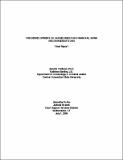|
Reseña:
|
This report summarizes our efforts to develop a guide for determining the appropriate amount of bond to recommend given the seriousness of the charges and level of risk posed by the defendant. The development of the bond guidelines involved three primary steps. First, we conducted focus groups with 27 line staff and supervisors to understanding how bond recommendations generally are made and to identify “best practices.” Second, we analyzed existing data on bail decisions for the years 2006 and 2007. In the final step, we developed and piloted the guidelines. The bond guidelines were piloted in four courts over three phases, with each phase representing a modified version of the ratings scales and guidelines. We compared the three phases in regard to the level of congruence between the bond amount suggested by the guidelines and the bond recommended in court, as well as the relationship of the offense characteristics and client risk ratings with the recommended bond. The implementation of the newly developed bond guidelines has the potential to address two areas of concern in the bond recommendation process. First, client risk factors continue to exhibit no consistent relationship to bond recommendations. The same factors that are used to assess risk during the initial intake (e.g., community ties, criminal history) should be carried through to subsequent decisions, including the bond recommendation. Formal training in the use of the bond rating scale and guidelines will encourage the consideration of these factors. Second, there continues to be a lack of consensus across staff and courts in regard to how much bond to recommend for a given case. Regular use of the guidelines is expected to result in greater consistency in bond recommendations across staff and courts. Future research should assess the long-term impact of the guidelines on pretrial decisions and outcomes. (palabras claves: fianza, servicios de antelación al juicio) |

